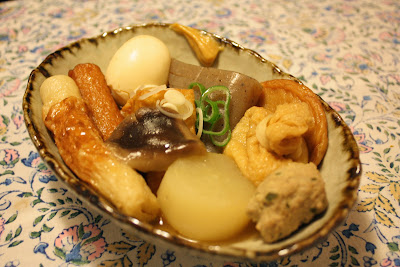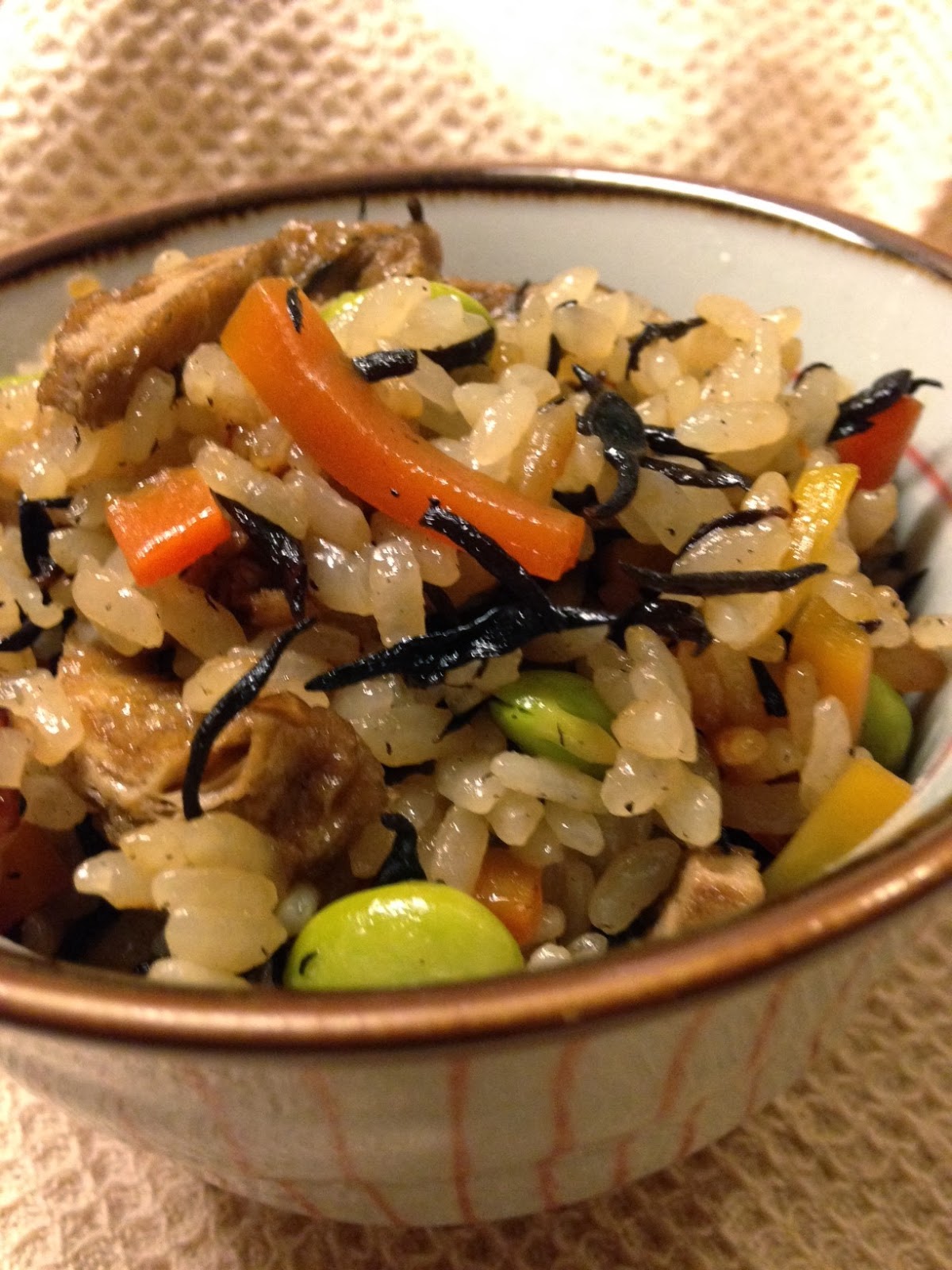Oden
Ingredients:
4 slices daikon, each about 3 cm thick
4 eggs
300 g block konnyaku
4 shiitake, washed and stems removed
2 squares atsuage
4 chikuwa
4 gobomaki (goboten)
4 satsuma-age (maruten)
4 mochiiri kinchaku
4 small potatoes
Chicken meatballs:
250 g chicken mince
1/3 stalk naganegi
1 tbsp. grated ginger
1 tbsp. soy sauce
1 tbsp. sake
1 tsp. salt
1 tsp. pepper
Simmering liquid:
1 piece konbu, about 24 cm in length
9 cups dashi broth
4 tbsp. mirin
1 tsp. salt
4 ½ tbsp. soy sauce
Garnish:
(optional) thinly sliced naganegi
(optional) Japanese 5-spice chilli mix. May substitute with cayenne pepper.
Karashi. May substitute with wasabi.
A note about the ingredients:
I realize that it might be difficult to find some of these items outside of Japan. Sometimes you'll find pre-packaged oden kits in Asian markets. You can also substitute with carrots, cabbage leaves (boil, then tie into tight rolls), burdock root, quail eggs, regular tofu, naganegi (use a wooden skewer to keep the leeks from falling apart), or weiners.
Serves 4. Time: 1 hour 45 mins. (minimum)
Directions:
1. Peel the daikon rounds and bevel the edges. (This will help the daikon keep its shape as it cooks.) Make a shallow cross-shaped incision on one side of the daikon. Gently boil the daikon in a small pot until half-cooked. Drain and set aside.
2. Hard-boil the eggs in a small pot and, when finished cooking (about 10 minutes), cool eggs in cold water. Peel and set aside.
3. Soak the konbu in cold water until softened. Cut the konbu into 4 equal strips (about 12 cm in length) and tie strips in knots.
4. In a large pot add dashi. (I made mine by adding a dashi “tea bag” to 9 cups of cold water.) Let simmer on low heat. Add the konbu knots, sake, salt and soy sauce.
5. Boil the konnyaku in a small pot for about 1 minute and drain. With a knife, lightly cut a grid pattern on the surface of the konnyaku. (This will help it absorb the simmering liquid.) Then cut into 4 equal triangles. Set aside.
6. Mix all the chicken meatball ingredients together, and with spoons, form the mince into 4 cm balls. Add the meatballs to the simmering pot. Add the shiitake to the pot.
 |
| Oops! I t's ground pork,but should've been chicken! |
7. Rinse the atsuage, chikuwa, satsuma-age, gobomaki and mochiiri kinchaku in cold water to remove excess oil. Cut the atsuage into 4 equal triangles, and the satsuma-age, in halves. (You don’t have to cut the satsuma-age, I just find that it’s easier to fit in my pot without ripping.) Peel and wash the potatoes. Add all ingredients to the pot and cover. Simmer over low heat so that the ingredients do not fall apart. Every now and again, push the ingredients down with chopsticks. When potatoes and daikon are soft, and the eggs and daikon take on a beige color, the oden is ready. For optimum flavor, allow to simmer for 2 ½ hours.
8. Divide ingredients between 4 deep bowls and ladle some of the simmering liquid over top. Don't forget to serve up the konbu knots, too-- they're really good for you! (Konbu has a lot of mineral iodine, iron and vitamin C.) Garnish with thinly sliced naganegi or Japanese 5-spice chilli mix. Smear a small amount of karashi to the side of the bowl and serve hot.
How I made out...
As with anything you simmer, it always tastes better the next day because everything has more time to absorb the flavors. I let the oden cook for about 1 hour and 20 minutes and it tasted good, but the flavors were definately more intense the next day.
I also noticed that my pot, although large, is more deep than it is wide. No big deal, but it was hard to check if some ingredients had cooked (like the potatoes) because they were under all the other stuff.
The verdict
It's hard to beat convenience store oden, but I think I did a respectable job. So said the flavor was spot-on. This made me happy because I decided not to use the instant oden flavoring that they sell at the grocery store. If you believe that you can make it from scratch, you can!











Comments
Post a Comment